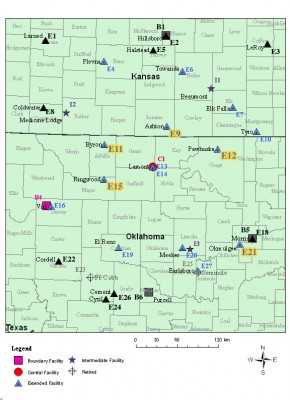Footprint Adjustments Underway at Southern Great Plains Site
Published: 28 February 2010

The ARM Southern Great Plains (SGP) site has historically operated a Central Facility, 23 extended facilities, 4 boundary facilities, and 3 intermediate facilities throughout its considerable domain. Beginning in October 2009, the SGP began a transition to a smaller, denser footprint (150 km x 150 km) by rearranging the original instrumentation and making accommodations for new instrumentation that will be added through the American Recovery and Reinvestment Act. The Central Facility and five extended facilities (9, 11, 12, 15, and 21) will remain, with the remaining and new instrumentation consolidated into 16 surface characterization facilities, 4 radar facilities, and 3 profiler facilities within the smaller domain. This new configuration will provide observations at scales more appropriate to current and future climate models.
The locations of potential new sites will capture the land use variation within the smaller domain. Some spatial analyses are still underway to validate the number and placement of the new sites. As they are identified and developed, instrumentation will be moved from the outer to inner sites. Combined with new instruments from the Recovery Act, this will produce a much denser network than the original domain—nearly the same measurement capabilities within an area one-fifth the size—providing much better sub-grid surface characterization. The ARM website will capture the status of the outer facilities as they are phased out and the new sites brought online. Data from the phased out facilities will remain available in the ARM Data Archive.
Numerous studies, including variational analyses, supported the move to a smaller SGP domain to more closely match modeling scenarios. In addition, SGP operations staff will be able to more efficiently maintain the site, especially during the winter when the outer road conditions are often unpassable.
The ARM Climate Research Facility is a DOE Office of Science user facility. The ARM Facility is operated by nine DOE national laboratories, including .
Keep up with the Atmospheric Observer
Updates on ARM news, events, and opportunities delivered to your inbox
ARM User Profile
ARM welcomes users from all institutions and nations. A free ARM user account is needed to access ARM data.


















